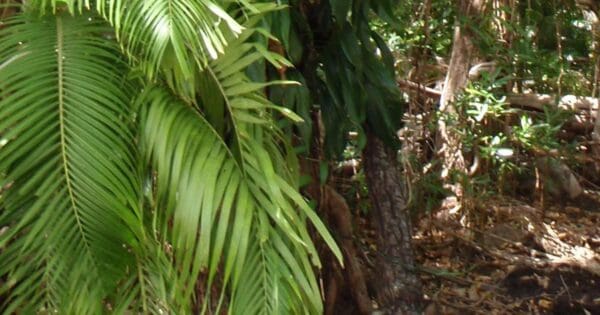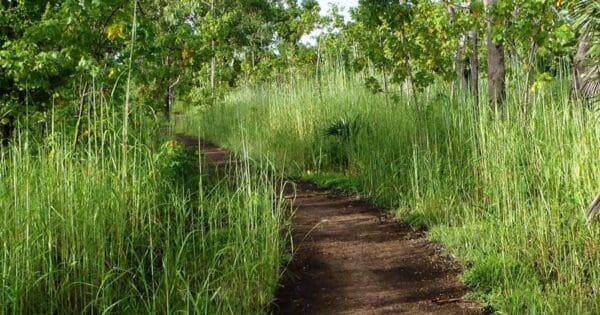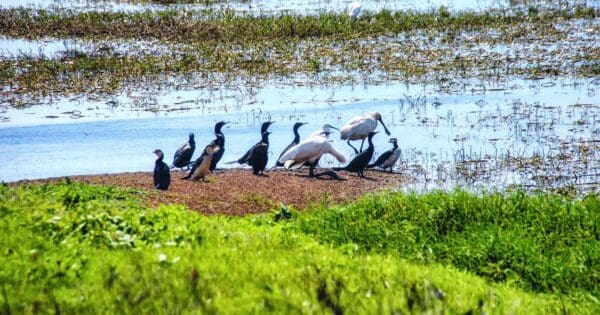Hike at a Glance
Max elevation: 0m
Min elevation: 0m
Total Ascent: 0m
Hike overview
Bardedjilidji Walk is one of Kakadu National Park's most interesting short walks. The 2.5 kilometre trail winds through layered sandstone, woodlands and wetlands alongside the East Alligator River. You can complete it by yourself or join the guided walk on Mondays.
Bardedjilidji is the local Aboriginal word for walking track or pathway, and also refers to the roots of waterlilies growing in freshwater swamps and billabongs. Experience a number of different habitats on the trail, from sandstone formations that were islands in the sea in at the time of the dinosaurs, to monsoon vine forest and wetland areas. Look for the black wallaroo in the early morning among the shaded sandstone outcrops. Stop at the cave that provides daytime shelter for insects, geckos and bats, and which once would have been a cool shelter for Aboriginal people. Look carefully to see some rock art here, but please do not touch/rub the paintings.
Track grade
Grade 2 (Easy) - A Gentle Introduction to Inclines: Grade 2 on the AWTGS represents easy walking tracks that offer a slightly more challenging experience compared to Grade 1. Similar to Grade 1, no prior bushwalking experience is required. The track surface is typically hardened or compacted and may have gentle hill sections or occasional steps. The total distance of a Grade 2 walk is typically no greater than 10 kilometers. These walks are still suitable for families with a bit more experience or those seeking a gentle introduction to some inclines.
Walk map and GPX file
Do you have a GPX file for this hike? Feel free to email it to me so I can add it to this hikes info.
Click to add your file >>
Content use
Please don’t copy GPX files or content from this site to AllTrails or other platforms. Each trail has been personally mapped, documented, and refined to support Australia’s bushwalking and hiking community. While some details come from land managers, every listing reflects significant personal effort. This is a free, community-driven initiative—your respect helps keep it that way.
Gallery
Got any photos from this hike? Your photos can help others plan. Share shots from along the trail so fellow hikers know what to expect.
Click to add your photos >>
Getting there
Getting to the trailhead: Kakadu National Park.
Situated within Kakadu National Park, the trailhead is easily accessible by car. If you’re travelling along the Kakadu Highway, the walk is conveniently located midway between Jabiru and Cooinda, the park’s two main service centres. The trail starts at a small car park 500 metres from the upstream boat ramp on the East Alligator River. Watch out for clear signage indicating the turn-off for the walk. Take this exit and follow the road for a short distance until you reach the designated carpark for the Mirray Lookout Walk. There, you can park your vehicle and prepare for the moderately challenging climb to the top.
Need a rental car to get you to the hike? Find one here.
About the region
Covering nearly 20,000 square kilometres, Kakadu National Park is a World Heritage listing renowned for both its cultural and natural values. See breathtaking horizons from the top of a Kakadu escarpment. Cruise on the stunning Yellow Water Billabong to spot crocodiles and wildlife in their natural habitat, including millions of migratory birds who in part call the park's wetlands home.
Not only is Kakadu spectacular, but you can feel yourself come alive among the lush rainforests, rocky gorges, serene swimming pools and the oldest Aboriginal rock art in the world. With more than 5,000 Aboriginal rock art sites in the park, the Bininj/Mungguy people have called Kakadu home for some 65,000 years. Here they'll teach you about their ancient culture and the regions' dramatic seasons.
Connect with the oldest living culture on earth. The rugged and remote beauty of Kakadu has stories to share that will take your breath away and touch your heart. In Australia's biggest national park you'll find ancient landscapes with thundering waterfalls, lush rainforests, wandering wetlands, exotic wildlife and ancient rock art.
Kakadu offers unrivalled walks to immerse you in nature, satisfy your appetite for adventure, or nurture your curiosity. Only three hours' drive from Darwin, Kakadu National Park has been waiting for you.
Find a place to stay
Wondering where to stay near this hike? Find accommodation close to the trailhead — hotels, cabins and campgrounds nearby. Click the button to view the interactive map.
Closest towns to this walk: Adelaide River, Arnhem Land, Batchelor, Cooinda, Darwin, Gunbalanya, Humpty Doo, Jabiru, Kakadu Village, Katherine, Maningrida, Mary River, Nourlangie, Pine Creek
Let someone know
Heading out? Fill in a trip intentions form so someone knows your plans. If things go wrong, they can raise the alarm fast, giving you peace of mind on the trail.
Similar walks nearby
Looking for more walks in or near Kakadu National Park? Try these trails with a similar difficulty grade.
Suggest an edit
Notice something different about this trail? Whether it’s a new feature, a route change, or a closure, share your update so we can keep our info accurate and helpful for fellow hikers.
Click to suggest edits >>
Explore safe
Plan ahead and hike safely! Carry enough water, pack layers for changing conditions, and bring safety gear like a torch, PLB, and reliable communication device. Check official sources for trail updates, closures, and access requirements, and review local weather and bushfire advice. Most importantly, share your plans with someone before you go. Being prepared makes for a safer and more enjoyable hike! Stay Safe, Explore More, and Always #ExploreSafe.
Packing checklists
What you carry in your pack depends on factors like weather, terrain, and your adventure type. Not sure what to bring? My free planning, food, and packing checklists are a great starting point, covering day hikes, overnight trips, and multi-day adventures. Use them to customise your kit and always prioritise safety.
Acknowledgement of Country
Trail Hiking Australia acknowledges the Traditional Owners of the lands on which we hike and pay respects to their Elders, past and present, and we acknowledge the First Nations people of other communities who may be here today.






